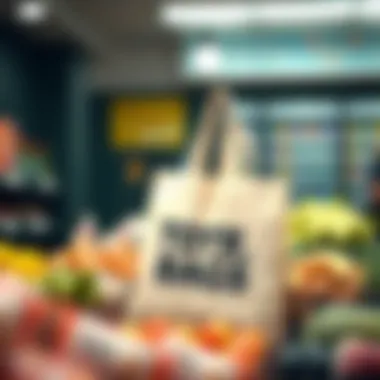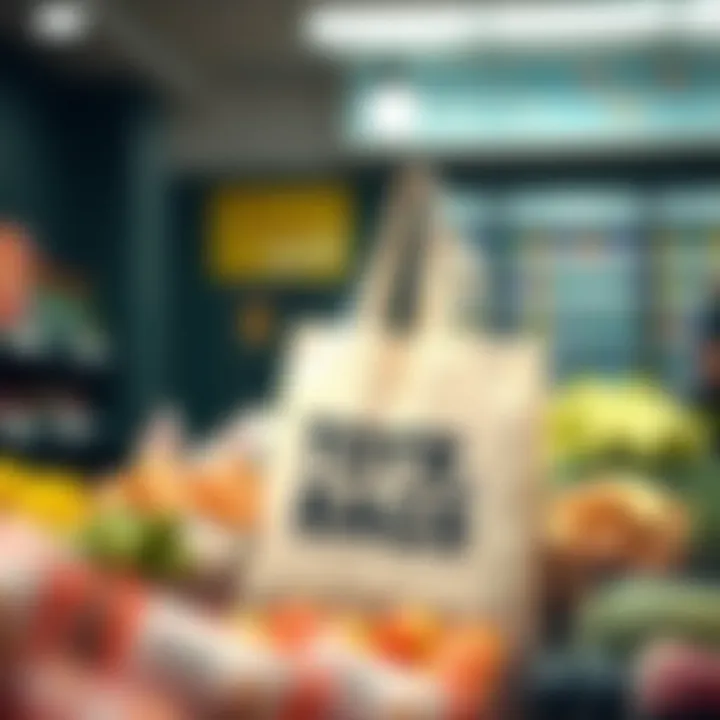The Significance and Evolution of Supermarket Tote Bags


Intro
Supermarket tote bags have evolved from mere shopping conveniences to cultural symbols of sustainability. As we continue to grapple with the environmental implications of our consumption habits, these bags stand at the forefront of a movement towards more eco-friendly practices. The significance of the tote bag extends beyond its ability to carry groceries; it reflects changing consumer attitudes, innovations in material design, and a shift in retail practices. In this exploration, we will delve deep into the multifaceted role of supermarket tote bags in our modern consumer culture, analyzing their functionality, material choices, and broader environmental impact.
Fashion Trends
Current Seasonal Trends
In the realm of fashion, supermarket tote bags are not just practical items; they are also powerful style statements. Currently, several trends dominate the landscape. Lightweight, durable fabrics, vibrant patterns, and minimalist designs are particularly in vogue. Bright colors and bold prints lend a playful edge, while neutral tones have found favor among those seeking simplicity and versatility.
Aside from aesthetics, functionality remains a priority. Reversible tote bags that offer two different looks in one piece are gaining traction. Additionally, many brands are collaborating with artists and designers, adding an element of uniqueness to these bags, allowing customers to express their individuality while making a less harmful choice for the planet.
Influential Designers and Their Impact
Several designers continue to push the boundaries of tote bag design. Take Stella McCartney, for instance. Renowned for her commitment to sustainability, she incorporates innovative eco-friendly materials into her designs. Similarly, other notable brands like Baggu and Etsy artisans have embraced the handmade movement, emphasizing craftsmanship and sustainability.
"Fashion is about more than just clothing; it encompasses lifestyle choices. Choosing a sustainable tote bag is a step towards responsible consumerism."
These designers are not just influencing fashion but also reshaping how consumers view convenience and style. When a recognizable name backs eco-conscious practices, it signals to the broader public that sustainability can be fashionable.
Material Evolution
The material choices for tote bags have seen significant advancements, reflecting a shift towards sustainable options. Traditional cotton and canvas remain popular, yet there’s a notable increase in the use of recycled materials. For instance, bags made from recycled PET bottles are making waves, combining durability with environmental consciousness.
Different materials cater to diverse consumer preferences. Some consumers lean towards organic cotton for its biodegradable properties, while others prefer synthetic options that offer water resistance and durability. Understanding these materials is crucial for both consumers and retailers, as they navigate the balance between quality, style, and sustainability.
Consumer Attitudes
As consumers become increasingly aware of their environmental footprints, the attitude towards tote bags has evolved. Many now view them as essential tools for daily life rather than disposable commodities. The rise of zero-waste movements has also fueled this change. People are more inclined to invest in high-quality tote bags that can last for years instead of succumbing to the convenience of single-use plastic.
Factors Influencing Choices:
- Brand Values: Shoppers often favor brands that align with their environmental values.
- Functionality: Practical features like pockets and foldability play a critical role in purchasing decisions.
- Community Influence: Social media trends and community-driven initiatives significantly sway consumer preferences toward sustainability.
Environmental Considerations
The environmental implications of choosing tote bags over single-use plastics are profound. However, it is essential to look beyond the surface impact. The production processes, transportation emissions, and eventual disposal of tote bags must also be considered. While opting for a fabric bag is undoubtedly better for the environment than plastic, its total life cycle must be accounted for.
Moreover, educating consumers on proper care and longevity can further enhance the environmental benefits of tote bags. For instance, suggesting methods to clean and repair bags can significantly extend their lifespan, minimizing waste.
As we continue to explore and dissect the various facets of supermarket tote bags throughout this article, a clearer picture will emerge depicting their growing importance in both the fashion world and the broader context of sustainable living. Through understanding these aspects, consumers can cultivate informed choices that align with their values while enjoying the practicality that tote bags offer.
Prelude to Supermarket Tote Bags
The world is changing, and so are our shopping habits. The importance of supermarket tote bags extends beyond mere convenience; they represent a shift towards sustainable living, touching on various aspects of our daily lives. As we move towards a more eco-conscious society, the tote bag has established itself as a vital tool not just for carrying groceries but also for fostering environmental awareness and promoting responsible consumption.
With a variety of designs and materials, these bags come loaded with benefits. They reduce our reliance on single-use plastics, thus playing a part in the global fight against pollution. Moreover, they often prove to be more durable and versatile than traditional plastic bags, serving multiple purposes beyond a simple trip to the store. In recent years, the evolution of the supermarket tote bag has paralleled our growing concerns about climate change and environmental impact, making it a topic worthy of exploration.
To fully appreciate the significance of supermarket tote bags, we must first define what they are and examine their historical context. Understanding their origins and how they have adapted over time provides insight into their current role and positions them as integral parts of modern consumer culture.
Defining the Supermarket Tote Bag
When we talk about supermarket tote bags, we're typically referring to bags designed with both durability and function in mind. These bags come in a variety of shapes and sizes, constructed from materials like canvas, jute, or even recycled plastics.
Unlike flimsy single-use bags, tote bags are designed to last. They often feature sturdy handles, giving them the ability to carry heavier loads. They are available in various styles—from minimalist designs to colorful prints, appealing to a wide range of consumers. Ultimately, the definition of a grocery tote transcends its physical form, encapsulating a value system that prioritizes sustainability, aesthetics, and utility.
"Tote bags are not just a way to transport goods; they are a statement about our choices and values in an increasingly disposable world."
Historical Context and Evolution
The journey of the tote bag isn't recent. Its roots can be traced back to the humble cloth bags used in artisanal markets long before plastic bags existed. Originally, these bags were a necessity, crafted for practicality and convenience. Over the decades, with the advent of plastic in the mid-20th century, reusable bags took a backseat as synthetic alternatives flooded the market.
However, the tide began to turn as environmental concerns grew in the late 20th century. The adverse effects of plastic pollution became widely recognized, prompting a revival in the popularity of reusable bags. By the early 2000s, supermarkets and retail stores began introducing branded tote bags, turning them into not just practical items but also fashionable accessories.
Today, the evolution of supermarket tote bags continues. They have become platforms for self-expression, with businesses leveraging them for branding and marketing purposes. Eco-friendly material choices, such as those made from post-consumer recycled materials, further reflect the changing values of consumers who seek to balance function with environmental stewardship. With this evolution, the tote bag has cemented its place in both our shopping routines and our everyday lives.
The Design Elements of Tote Bags
When considering supermarket tote bags, one can’t overlook the significance of design elements. These aspects go beyond mere aesthetics; they touch on functionality, user experience, and environmental consciousness. A tote bag designed thoughtfully can make shopping trips more favorable while also contributing to sustainability efforts. Each component plays a role in the overall success and appeal of a tote bag, informing consumers' choices as much as their fashion sensibilities.


Materials Utilized in Tote Creation
Canvas
Canvas is a household name in the world of tote bags. This fabric, known for its durability and strength, has become a staple in the creation of bags meant for carrying substantial loads. A key characteristic of canvas is its robustness, allowing it to endure heavy groceries without fraying or ripping. Its dense weave makes it an ideal choice for those who require longevity in their bags, as it can often last for years when well cared for.
A unique feature of canvas is its ability to be printed on easily. Many brands utilize canvas as a blank canvas, quite literally, for striking designs and patterns to attract consumers. However, one might argue that its weight can be a downside, especially when considering portability. Its sturdiness comes at a cost; heavier bags can become cumbersome during long shopping errands.
Recycled Plastics
The use of recycled plastics in tote bags has seen a surge, aligning with the growing emphasis on sustainability. These bags come from materials that might otherwise clutter our landfills. A notable characteristic of recycled plastics is their versatility; they can be molded into various designs while still maintaining a lightweight structure, making them popular among consumers.
The unique feature of these bags is their contribution to reducing overall plastic waste. Instead of contributing further to the issue, purchasing a tote made from recycled materials actively participates in a solution. However, there are disadvantages to be noted, including concerns regarding the bag's strength; not all recycled plastic totes are created equal, and their durability can vary significantly based on how the materials were processed.
Jute and Hemp
Jute and hemp offer a different flair and feel often sought after in eco-conscious circles. Both materials are natural fibers, gaining traction because of their biodegradable nature. Jute, in particular, is recognized for its rough texture and capacity to hold heavy items. It has a rustic appeal, which makes it desirable for those looking to make an environmental statement.
Hemp, on the other hand, exhibits remarkable resilience. It is resistant to mold, mildew, and ultraviolet light, lending itself well to tote bags designed to last. These fibers contribute to the eco-friendly trend, as they can be grown with fewer pesticides and fertilizers. Despite their strengths, consumers may find that jute can wear down faster when exposed to moisture, which limits its usability under certain conditions.
Functional Features to Consider
Size and Capacity
The size and capacity of a tote bag is perhaps one of the most critical considerations for shoppers. A bag that strikes a balance between spacious and manageable is key; larger bags can carry more but may sacrifice ease of handling. Size can also be closely tied to the kind of shopping trips someone intends to take. Regular grocery runs might dictate a need for a more spacious bag, while quick stops may suffice with a smaller size.
A unique feature to highlight is the adaptability of tote sizes. Many designs offer a variety of sizes, catering to different needs and shopping behaviors. However, a downside can be that larger totes may lead to overloading, making them less comfortable to carry.
Handle Design
Handles are another vital design element that dictates user experience. The comfort of a handle can make or break the use of a tote bag, especially when it comes to weight distribution and grip. Most tote bags feature either short or long handles, each serving distinct purposes; shorter handles can be excellent for quick trips, while longer ones are easier to carry over the shoulder.
One unique consideration is the material of the handle itself. Cotton webbing is common, often adding to comfort but sometimes lacking in durability. Leather handles, while stylish, can work well for lighter uses but may become heavy in larger bags when full. The balance of comfort and practicality is a key factor for good handle design, and the wrong choice can lead to awkward handling.
Closure Options
Closure options are often overlooked but can significantly affect functionality. Zippers, snaps, and open tops each provide different user experiences. Zippers offer security, ensuring that items stay put, whereas snap closures give a blend of accessibility and style. A significant appeal to an open-top design is ease of access during busy shopping trips.
In terms of disadvantages, zippers can malfunction and lead to frustration when users need to retrieve items quickly. Similarly, open bags might pose a risk of spilling contents if not managed carefully. The choice of closure ultimately hinges on how the user prioritizes convenience against the risk of item loss during transit.
Effective design in tote bags highlights the balance of function and style, emphasizing not just aesthetics, but lasting utility.
In summary, the design elements of tote bags encompass critical aspects that consumers must consider when choosing. From the materials chosen to the handle designs and functional features, each aspect contributes significantly to the bag's utility and appeal. Understanding these components allows for smarter shopping decisions while also highlighting the evolving nature of tote bags in modern retail.
Cultural Impact of Tote Bags
Supermarket tote bags have transcended their original function as mere shopping necessities. They have become more than just a means to carry groceries; they embody a cultural phenomenon that reflects changing consumer values and societal trends. Understanding the cultural impact of tote bags reveals insights into their significance as both utilitarian items and symbols in modern life. This section delves into how tote bags are reshaping not just shopping habits but also the fashion landscape and popular culture.
Tote Bags as Fashion Statements
In recent years, tote bags have emerged as fashion staples that often speak volumes about the wearer’s personal style, values, and even social consciousness. Designers and brands have recognized this shift, launching bags that are not only practical but also chic accessories. The notion of style is being rewritten as tote bags, often seen in trendy patterns, colors, and designs, become as crucial as the outfit itself.
These bags serve dual purposes—functionality and aesthetic appeal. Fashion enthusiasts embrace tote bags adorned with eye-catching prints or limited-edition designs, making them valuable articulations of identity. Think about it: a plain canvas tote carries a different weight than a designer tote splashed with vibrant graphics.
- Sustainable Fashion: The rise of eco-awareness among consumers creates a niche where tote bags are celebrated for their minimal environmental impact. Brands like Baggu and Everlane focus on creating stylish yet sustainably produced bags that appeal to conscious buyers.
- Customization: The trend of personalizing tote bags, be it through embroidery, screen printing or patches, transforms them into unique pieces of self-expression. This trend isn't just about wearing your heart on your sleeve—it's about showcasing your individuality right on your tote.
"For many, the tote bag represents a new wave of consumerism—one where mindfulness and style go hand in hand."
Tote Bags in Popular Culture
The journey of tote bags from utilitarian objects to cultural icons is visible in various forms of popular media. In television shows, films, and social media, tote bags have made cameo appearances, often symbolizing a character's lifestyle or socio-economic status. Consider famous personalities who rock their tote bags with pride, whether it’s a chic tote juxtaposed against casual attire or a designer piece paired with high fashion. This portrayal pushes the narrative that tote bags are not simply mundane shopping aids, but rather essential components of a person's ensemble.
Moreover, tote bags have found a home in social conversations. Hashtags on platforms like Instagram and TikTok trend around tote bags as influencers showcase their unique styles or DIY creations. This integration into social media culture enhances visibility and promotes a cycle of innovation within the tote bag market. It becomes a badge of honor for millennials and Gen Z, who value sustainability and creativity.
- Media Appearances: From Friends to Sex and the City, tote bags feature prominently as icons of casual urban living. They are often depicted as essential accessories for the modern, bustling lifestyle.
- Artistic Collaborations: The marriage of art and function is seen as artists partner with brands to create visually engaging tote designs, turning everyday bags into canvases for expression. Artists like Keith Haring or Yayoi Kusama have made waves with their limited edition designs for brands like Louis Vuitton, further blending culture with commerce.
In summary, tote bags have carved out their niche, redefining their purpose as both functional items and cultural symbols that resonate with consumer consciousness. As the conversation around sustainability, fashion, and cultural relevance continues, the humble tote bag stands at the forefront, representing a shift towards more intentional and stylish choices. From everyday practicality to a statement of social values, tote bags are more than just carriers; they are woven into the very fabric of modern culture.
Sustainability and Environmental Considerations
The conversation around sustainability and environmental considerations has surged in recent years, especially as society grapples with the mounting challenges of climate change and ecological degradation. There is a growing recognition of the footprint each product leaves on the environment, including everyday items like supermarket tote bags. These bags, once merely seen as practical carriers, are evolving into symbols of sustainability for conscientious consumers.


The importance of sustainability in the context of supermarket tote bags can't be overstated. They act as alternatives to single-use plastic bags, contributing to reduced plastic waste in landfills and oceans. By embracing cloth and biodegradable materials, these bags facilitate a transition to more eco-friendly habits. This shift not only helps the environment but also fosters a mindful approach towards consumption.
Reducing Plastic Waste
One fundamental issue addressed by the rise of supermarket tote bags is the alarming rate of plastic waste entering our environment. Traditional plastic bags are widely recognized as problematic; they often end up in landfills and oceans, taking hundreds of years to decompose. In contrast, tote bags crafted from sustainable materials provide a tangible solution. The impact of using these bags is remarkable:
- Reducing overall plastic consumption
- Minimizing litter, which targets the preservation of wildlife habitats
- Encouraging more responsible consumer choices
Many retailers now incentivize the use of tote bags by offering discounts to customers who bring their own bags. This not only promotes the concept of reusability but also aligns businesses with eco-friendly practices. The more individuals choose to use tote bags, the greater the collective contribution towards mitigating plastic pollution.
The Lifecycle of a Tote Bag
Understanding the lifecycle of a tote bag allows consumers to appreciate its value beyond the initial purchase. This lifecycle can be divided into key stages, from production through disposal, illuminating the broader impact each bag has on the environment.
Production Processes
The production processes of tote bags have come a long way, driven by advancements in sustainable manufacturing techniques. Many bags are now made from materials like organic cotton or recycled polyester, which reduce reliance on virgin materials.
Key characteristics include:
- Sourcing: Eco-friendly materials are increasingly sourced from suppliers committed to sustainable practices.
- Manufacturing: Efficient production techniques reduce energy consumption and waste.
This focus on sustainability provides benefits not just to the environment but also to the consumer — often translating to better durability and quality. However, it’s essential to acknowledge that not all production methods are equal. Some may still involve chemicals or practices detrimental to the planet, demanding vigilance from conscientious shoppers.
Longevity and Durability
The longevity and durability of a tote bag contribute significantly to its environmental benefits. A well-made tote bag can last for years, often far exceeding the lifespan of traditional plastic bags.
- Quality Over Quantity: Emphasizing durability means consumers are less likely to replace bags frequently, leading to reduced consumption overall.
- Versatile Uses: Durable tote bags can be employed in various contexts beyond shopping, such as gym bags or beach totes, further enhancing their utility.
On the flip side, lower-quality tote bags may soon wear out, resulting in increased waste over time. It's crucial for consumers to invest in high-quality options that stand the test of time, ensuring that their commitment to sustainability translates to tangible results.
Investing in a reusable tote bag is investing in a cleaner planet. Each bag carries the potential to lessen our reliance on single-use plastics and protect our environment for future generations.
As consumers become more intentional with their choices, understanding the lifecycle of their tote bags emphasizes the impact every small decision can make. Whether it’s opting for higher-quality bags or being mindful about how they are used and cared for, there's much to reflect on when it comes to contributing to sustainability.
For those keen to dive deeper into sustainable practices, additional resources can be accessed at Wikipedia's sustainability initiatives or Britannica covering eco-friendly practices.
Consumer Attitudes and Trends
The landscape of consumer choices is ever-evolving, influenced by a myriad of factors such as environmental awareness, convenience, and personal style. This section focuses on the importance of understanding consumer attitudes and trends in relation to supermarket tote bags. These reusable bags are not just a functional item; they reflect the shifting values and priorities of today's buyers. The desire for sustainable alternatives to single-use plastic is reshaping how people view these bags, making them not only a shopping necessity but a statement about personal and communal responsibility.
Shifting Perspectives on Single-Use Bags
In recent years, there’s been a noticeable shift in how consumers perceive single-use plastic bags. Many view them as a relic of past habits, a lightweight option that carries heavy consequences. Several factors contribute to this change:
- Awareness of Environmental Impact: Documentaries and news reports have brought to light the detrimental effects of plastic pollution. Many people now consider the fate of their discarded plastic bag, which often ends up in oceans, harming marine life.
- Legislative Actions: Numerous governments have implemented bans or fees on plastic bags to curb their use. This legal shift pushes consumers to reconsider their options.
- Social Influences: The rise of eco-conscious influencers on platforms like Instagram and Facebook encourages followers to embrace sustainable alternatives. The more they see their peers sporting stylish tote bags, the more they are inclined to follow suit.
As these perspectives evolve, supermarket tote bags are emerging as not just an alternative, but a preferred choice. They represent a conscious decision to reduce waste and promote sustainability.
Purchasing Patterns for Supermarket Tote Bags
Understanding purchasing behaviors helps retailers tailor their offerings. Let's break this down into two significant aspects: Market Growth and Demographics of Tote Users.
Market Growth
The market for supermarket tote bags has seen impressive growth. This surge can be attributed to:
- Rising Demand for Eco-Friendly Products: Consumers are increasingly prioritizing sustainability in their purchases, driving an upward trend in tote bag sales. Often, shoppers opt for bags that are reusable and made from recycled materials, which contributes positively to the environment.
- Branding Initiatives: Retailers are promoting their own branded tote bags, often tying in promotions that encourage use, such as offering discounts for shoppers who bring their bags. This creates a cycle of loyalty, as using a tote bag becomes synonymous with a positive shopping experience.
The unique feature of this growth lies in its potential. It serves as a positive feedback loop, encouraging more brands to invest in high-quality, appealing tote bags, further driving consumer engagement.
Demographics of Tote Users
Examining who uses tote bags reveals rich insights into market dynamics:
- Age Group Trends: Younger consumers, especially millennials and Gen Z, are leading the charge in adopting tote bags. Their desire for sustainability aligns perfectly with the ethos of reusable bags. In contrast, older generations still tend to rely on plastic bags, indicating a potential area for targeted marketing.
- Income Level Considerations: Interestingly, tote bag usage spans across various income levels. However, typically, higher-income consumers may invest in higher-end tote options, such as designer collaborations, reflecting a status symbol alongside their eco-conscious choices.
With this nuanced understanding, it's clear that the demographics of tote users emphasize the importance of thoughtful design and marketing strategies that resonate with specific segments.


"Consumer habits are not just about the items they choose, they reflect deeper values and aspirations, especially in a world facing environmental challenges."
In summary, tracking changes in consumer attitudes and their purchasing patterns should be the backbone of strategies for suppliers. This insight brings to light the evolving complexities of this market and sets the stage for innovations that can meet the demands of today's environmentally aware shoppers.
Practical Uses Beyond the Supermarket
Supermarket tote bags are not just useful for grocery shopping; their practicality extends into various facets of daily life. In an age where sustainability is paramount, these bags offer numerous benefits beyond mere shopping. They are versatile, stylish, and environmentally friendly alternatives to disposable bags, and they serve a multitude of purposes that cater to diverse needs, preferences, and lifestyles.
Versatility in Everyday Life
Beach Trips
Imagine a sunny day at the beach. A tote bag is often a staple when packing a day’s worth of essentials such as towels, sunscreen, snacks, and a good book. The key characteristic of beach trips is the ability to hold numerous items while being easy to carry.
Tote bags designed for beach outings typically include durable materials that resist water and sand. Unique features can range from insulated compartments for drinks to compartments for wet items, thus enhancing the overall beach experience. Their advantages lie in their flexibility and capacity to accommodate various items without compromising on style. However, a potential downside is that not all tote bags are waterproof, which can be a critical factor when packing them for sandy or wet environments.
Gym Bags
Gym-goers are increasingly shifting towards using tote bags instead of traditional gym duffels. The appeal of using a tote bag for gym travel lies in their spaciousness and design. A classic tote bag can carry gym clothes, water bottles, workout gear, and even a quick snack, making it a beneficial choice for fitness enthusiasts.
Unique features like specialized compartments for shoes and sweat-resistant lining add to the practicality of using tote bags for this purpose. However, they may not always come with the padded straps found in conventional gym bags, which could pose comfort issues during long commutes to and from the gym. Nonetheless, the stylish look of a tote can inspire gym-goers to keep fitness fashionable.
Storage Solutions
The role of tote bags in storage solutions cannot be underestimated. They offer a simple yet effective way to organize various items, whether at home, in a car, or even in an office. Key characteristics of using tote bags for storage include their stackable design and durability, allowing them to be easily nested together when not in use.
Tote bags can efficiently serve as storage for toys, blankets, or even seasonal clothes. Their unique feature lies in their capacity to be both functional and visually appealing, unlike traditional plastic bins or boxes. However, this function can become limited once the bag is too full, making it cumbersome to move around. Still, they remain a popular and versatile choice for organizing everyday belongings.
Customizing Tote Bags for Personal Utility
Customization adds a personal touch to tote bags, making them suitable for various uses. From adding initials to unique prints, customization reflects individual style and purpose. This aspect allows tote bags to transition seamlessly from functional items to personalized accessories, further enhancing their appeal in contemporary culture.
"A customized tote bag is more than just a bag; it’s an expression of identity and purpose."
Branding and Marketing Potential
The role of supermarket tote bags in branding and marketing has grown tremendously in recent years. These bags offer a unique platform for companies to communicate their values and establish a recognizable identity. With consumers increasingly favoring sustainability and eco-conscious choices, the tote bag serves as an effective medium for brands to position themselves accordingly.
Producing customized tote bags extends beyond just utility; it transforms everyday shopping into an experience laden with visual identity and promotional significance. By using tote bags emblazoned with logos or catchy taglines, brands can elevate their presence in a competitive market. An enticing design not only catches the eye but also functions as a walking advertisement. Moreover, tote bags have a longer lifespan compared to standard disposable bags, thus prolonging the brand's visibility among potential customers.
Enhancing Brand Recognition Through Tote Bags
Supermarket tote bags can become synonymous with brands, creating a visible association in consumers' minds. When a customer uses a tote bag in various settings — at the grocery store, a beach day, or a local farmer's market — they're effectively promoting the brand. The act of carrying a branded tote bag translates into a form of social currency. Each time someone sees the bag, it’s an opportunity for recall and recognition.
Benefits of enhanced brand recognition through tote bags include:
- Consistency in Design: Using a coherent color scheme and logo placement assures customers easily connect with the brand.
- Durable Advertising: The longevity of tote bags means they can be seen multiple times over their lifespan, increasing exposure without ongoing costs.
- Word of Mouth: There's something about carrying a stylish tote that sparks conversations, and discussions around the brand can grow organically.
Collaborations with Designers and Influencers
Brands are increasingly collaborating with designers and influencers to create exclusive tote bags that resonate with specific audiences. This strategy harnesses the reach and credibility of well-known figures, merging the worlds of marketing and creativity.
Collaborations often highlight unique designs that cater to fashion-savvy consumers, making the bags trendy and desirable. Social media campaigns amplify these partnerships, ensuring that tote bags become more than just practical items; they morph into coveted fashion statements.
Collaborative efforts can involve:
- Limited Edition Releases: Creating a sense of urgency can compel consumers to purchase tote bags that feel exclusive and unique.
- Co-Branded Merchandise: Joining forces with established names can enhance crossover appeal, attracting consumers who may not be loyal to a specific brand but appreciate the collaboration.
- Sustainable Fashion Initiatives: Partners that value eco-friendliness can highlight this aspect, positioning tote bags not only as stylish choices but as responsible purchases.
Brands venturing into tote bag collaborations often see a positive alignment with their consumer's expectations, resulting in a boost in sales and overall brand loyalty.
"Tote bags are essential tools for sustainable branding; they turn eco-conscious choices into everyday style statements."
By strategically leveraging tote bags within their marketing approaches, brands can effectively carve out a niche that appeals to a wider clientele while remaining relevant in an ever-evolving retail landscape.
For further insights:
Marketing Resource
Branding Insights
End: The Future of Bagging
The future of tote bags, especially in the supermarket context, rests upon evolving consumer habits, environmental concerns, and innovative design approaches. As the world turns increasingly towards sustainable practices, these bags stand at the forefront of change, weaving together convenience and conscious living. Their relevance stems not merely from practicality but the cultural narrative they embody in modern society.
Staying Relevant in a Changing Environment
As retail landscapes transform, so too do the demands placed on supermarket tote bags. Today, shoppers are discerning; they seek bags that align with their lifestyle choices. The continuous push for environmental sustainability makes it crucial for brands and retailers to adapt.
For instance, brands are now rethinking not just what a tote bag is made from, but also how it integrates into a broader strategy of waste reduction and eco-friendliness. Here are a few elements to consider:
- Material Choices: Switching to biodegradable or recycled materials can make a difference.
- Public Awareness: Engaging customers in understanding the impact of their choices fosters loyalty.
- Functional Design: Providing bags that are versatile in design, like those that fold easily or serve multiple purposes, will resonate more with consumers.



